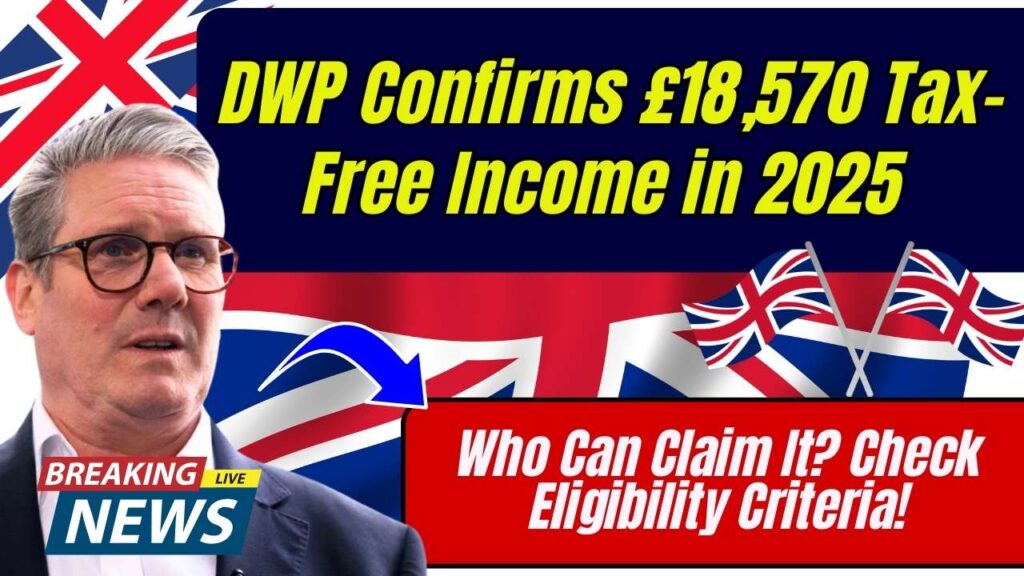DWP Confirms £18,570 Tax-Free Income in 2025 – Are you wondering how you can earn up to £18,570 tax-free in 2025 in the UK? The Department for Work and Pensions (DWP) and HMRC allow eligible individuals to combine multiple tax allowances to enjoy this substantial tax-free income threshold. If you’re retired, have savings interest, or fall into a low-income category, this could be a game-changer for your finances.

Let’s break it all down into simple terms. Whether you’re planning your retirement income, managing your savings, freelancing part-time, or just trying to reduce your tax burden, this friendly yet detailed guide will help you understand how to legally avoid paying tax on up to £18,570 in the 2025/26 financial year.
DWP Confirms £18,570 Tax-Free Income in 2025
| Details | Explanation |
|---|---|
| Maximum Tax-Free Income | £18,570 for the 2025/26 tax year |
| Components | Personal Allowance: £12,570 Starting Savings Rate: Up to £5,000 Personal Savings Allowance: £1,000 |
| Eligibility | UK resident, low non-savings income, savings interest earned |
| Target Groups | Retirees, low-income earners, part-time workers, savers |
| Tax Implication Above Limit | Income above £18,570 taxed at standard UK rates (20%, 40%, or 45%) |
| Tax-Free For Couples | Potentially up to £37,140 if both meet the criteria |
| Official Info | Visit GOV.UK – Income Tax |
The £18,570 tax-free income strategy in 2025 is a powerful and underused method for UK taxpayers to reduce their liability. By understanding how the Personal Allowance, Starting Rate for Savings, and Personal Savings Allowance interact, individuals can plan their finances more wisely.
Whether you’re a pensioner, part-time worker, student, or smart saver—this is an opportunity you shouldn’t miss. It’s fully legal, backed by HMRC, and easy to achieve with a little planning. Don’t forget to explore ISAs and Premium Bonds for added benefits.
What Is the £18,570 Tax-Free Income in 2025?
This figure isn’t a new benefit or government scheme—it’s a smart combination of three existing tax allowances. When used together, these allowances can significantly reduce or eliminate the income tax burden on modest earners.
1. Personal Allowance (£12,570)
This is the income amount you can earn before any income tax is due. It covers employment income, pensions, and most types of non-savings income.
2. Starting Rate for Savings (Up to £5,000)
This lesser-known allowance benefits those whose other income is below £12,570. You may qualify for up to £5,000 of savings interest tax-free. However, every pound of income over the personal allowance reduces this allowance.
Example: A pension income of £11,000 allows you the full £5,000 Starting Rate. If you earn £13,000, your Starting Rate drops to £4,570.
3. Personal Savings Allowance (£1,000)
If you’re a basic-rate taxpayer, you also receive a tax-free savings interest allowance of £1,000. This means you could earn £1,000 from bank interest before any tax applies, on top of the other two allowances.
Who Can Benefit the Most?
Not everyone can take full advantage of all three allowances, but many individuals and households may still benefit significantly.
Retirees
Retirees with income below £12,570 from pensions or annuities and moderate savings interest will often qualify to use the full £5,000 Starting Rate and the additional £1,000 Personal Savings Allowance.
Low-Income Workers and Freelancers
Many part-time workers, freelancers, gig workers, or those on variable incomes may fall below the income threshold needed to qualify.
Students and Young Professionals
Those just starting out in the workforce with small incomes but higher interest savings or inheritance can benefit too.
Stay-at-Home Partners
Non-working or low-earning spouses may also benefit from transferring assets into savings accounts in their name to make full use of their personal and savings allowances.
How to Maximise the £18,570 Tax-Free Income?
Step 1: Understand Your Income Breakdown
Identify your non-savings income (salary, pension, etc.) and savings interest income. If your non-savings income is below £12,570, you’re well positioned to qualify for the full set of allowances.
Step 2: Choose the Right Savings Products
Use tax-efficient savings products like:
- Fixed deposits
- High-interest current or savings accounts
- Cash ISAs for tax-free growth beyond the £18,570
- NS&I bonds or Premium Bonds (prizes are tax-free)
Platforms like MoneySavingExpert list the best rates for UK savers.
Step 3: Combine Allowances Intelligently
Let’s say your total income looks like this:
- £10,000 (from part-time work or pension)
- £3,000 in savings interest
You still have £2,570 unused from your Personal Allowance, plus £5,000 under the Starting Rate, and £1,000 from your Personal Savings Allowance. That’s up to £18,570 total income tax-free.
Step 4: Optimize Across Households
If you’re married or in a civil partnership, consider shifting savings or income streams to the lower-earning spouse to maximize both sets of allowances, potentially reaching £37,140 tax-free.
Step 5: Monitor With HMRC Tools
Use the HMRC Personal Tax Account to track your income, interest earned, and ensure you’re within your thresholds.
Step 6: Submit a Self-Assessment If Needed
If your savings income exceeds £1,000 and your provider hasn’t deducted tax, you might need to file a Self-Assessment. Find out more at GOV.UK – Self Assessment.
Real-Life Case Study: Sarah, Age 67
Sarah is retired and receives £9,500 from her pension. She also has £60,000 in savings earning 5% interest annually, or £3,000.
- Pension: £9,500 (tax-free under Personal Allowance)
- Savings interest: £3,000 (covered by £3,070 remaining allowance, £5,000 Starting Rate, and £1,000 Savings Allowance)
Result: Sarah doesn’t owe a single penny in tax.
Now imagine her husband, James, has the same profile. Together, they can legally earn £37,140 tax-free.
More Ways to Keep Your Income Tax-Free
Open or Maximise an ISA
You can deposit up to £20,000 per year in a cash or stocks and shares ISA, and all gains are tax-free. Even if you exhaust the £18,570 allowance, ISAs are still your best friend.
Use Premium Bonds
NS&I Premium Bonds offer monthly prize draws. You won’t earn interest, but you can win tax-free money. It’s 100% safe, backed by the government.
Diversify Across Family Members
Put savings accounts in the name of lower-earning partners or adult children. Be mindful of gifting rules and potential inheritance tax implications.
Track With Budgeting Tools
Use apps like Emma, Yolt, or Moneyhub to get a real-time view of your income, interest, and tax status. Many connect directly to HMRC.
What Happens If You Exceed the £18,570 Limit?
Once you go beyond these thresholds:
- The amount exceeding is taxed at 20% (basic), 40% (higher), or 45% (additional)
- The Personal Savings Allowance drops to £500 for higher-rate taxpayers
- Additional rate taxpayers lose the savings allowance entirely
Example: If you earn £20,000 in total income (with £14,000 non-savings and £6,000 in savings interest):
- Personal Allowance covers £12,570
- Starting Rate drops to £3,570
- You get £1,000 Savings Allowance (if basic rate)
- £860 of your interest will be taxable
£6,300 Annual PIP Cuts: How Will It Impact Benefits Claimants?
FAQs
1. Is £18,570 a new allowance?
No, it’s a combination of existing allowances you may not be using fully.
2. Can couples double the benefit?
Yes. If both partners qualify separately, you can earn up to £37,140 as a household, tax-free.
3. What income qualifies for the savings allowances?
Interest from bank accounts, bonds, credit union savings, and some income from fixed-term savings products.
4. Do I need to report all savings income?
Yes, especially if your provider doesn’t deduct tax at source and your total interest exceeds £1,000.
5. Do ISA earnings count toward the £18,570?
No. ISA interest or capital gains are completely separate and do not impact the thresholds.
6. Where can I check my tax status?
Log in to your HMRC personal account or use their calculator tool.










